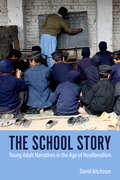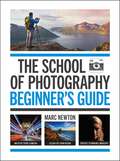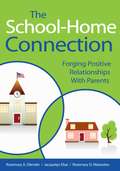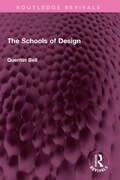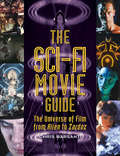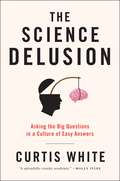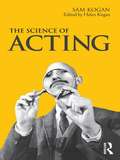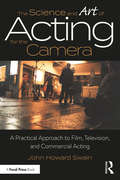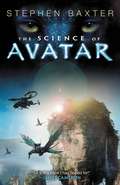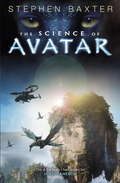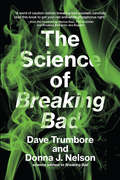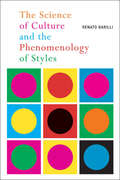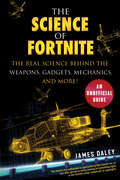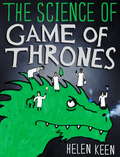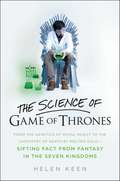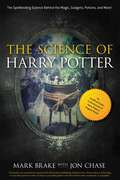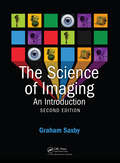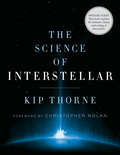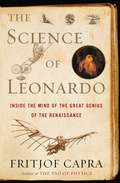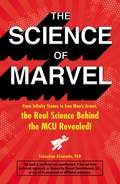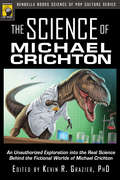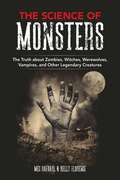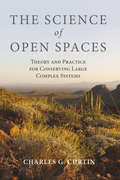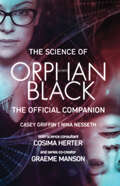- Table View
- List View
The School Story: Young Adult Narratives in the Age of Neoliberalism (Children's Literature Association Series)
by David AitchisonThe School Story: Young Adult Narratives in the Age of Neoliberalism examines the work of contemporary writers, filmmakers, and critics who, reflecting on the realm of school experience, help to shape dominant ideas of school. The creations discussed are mostly stories for children and young adults. David Aitchison looks at serious novels for teens including Laurie Halse Anderson’s Speak and Faiza Guène’s Kiffe Kiffe Tomorrow, the light-hearted, middle-grade fiction of Andrew Clements and Tommy Greenwald, and Malala Yousafzai’s autobiography for young readers, I Am Malala. He also responds to stories that take young people as their primary subjects in such novels as Sapphire’s Push and films including Battle Royale and Cooties. Though ranging widely in their accounts of young life, such stories betray a mounting sense of crisis in education around the world, especially in terms of equity (the extent to which students from diverse backgrounds have fair chances of receiving quality education) and empowerment (the extent to which diverse students are encouraged to gain strength, confidence, and selfhood as learners). Drawing particular attention to the influence of neoliberal initiatives on school experience, this book considers what it means when learning and success are measured more and more by entrepreneurship, competitive individualism, and marketplace gains. Attentive to the ways in which power structures, institutional routines, school spaces, and social relations operate in the contemporary school story, The School Story offers provocative insights into a genre that speaks profoundly to the increasingly precarious position of education in the twenty-first century.
The School of Photography: Beginner's Guide
by Marc NewtonThe School of Photography: Beginner's Guide will take the beginner photographer to an advanced level in no time and fill any gaps in photography knowledge that may be holding you back from reaching your full potential. You'll be able to use your camera confidently in all the manual modes and apply the knowledge gained to any situation. The book will make you feel completely confident and ensure your shots stack up against any professional-looking photography.It's for people who want to take photography more seriously and will suit beginners, keen enthusiasts or anyone looking to make photography their profession. This book will put an end to any confusion, while giving you accurate and thorough knowledge in photography.Topics covered include:- Camera kits and equipment- Working in manual settings- Composition- Apertures and depth of field- Shutter speeds- Night photography
The School of Photography: Beginner's Guide
by Marc NewtonThe School of Photography: Beginner's Guide will take the beginner photographer to an advanced level in no time and fill any gaps in photography knowledge that may be holding you back from reaching your full potential. You'll be able to use your camera confidently in all the manual modes and apply the knowledge gained to any situation. The book will make you feel completely confident and ensure your shots stack up against any professional-looking photography.It's for people who want to take photography more seriously and will suit beginners, keen enthusiasts or anyone looking to make photography their profession. This book will put an end to any confusion, while giving you accurate and thorough knowledge in photography.Topics covered include:- Camera kits and equipment- Working in manual settings- Composition- Apertures and depth of field- Shutter speeds- Night photography
The School-Home Connection: Forging Positive Relationships with Parents
by Rosemary A. Olender Jacquelyn Elias Rosemary D. MastroleoResearch has consistently shown that student success is directly related to the strength of the relationships between parents and schools. In The School-Home Connection, the authors draw on original research and their professional experiences to identify the common sources of both negative and positive school-home relationships. The book presents a comprehensive approach to building closer connections and includes:Tools to help educators develop a deeper understanding of the communities they serveStrategies for improving interpersonal skills and communication skillsA chapter on the importance of documenting and celebrating school eventsGuidelines for creating three distinct levels of parental participation in schoolsWith suggestions for cultivating a community network of support services and a summary of lessons for forging constructive relationships, The School-Home Connection is an essential tool for educators looking to strengthen the learning community and increase student achievement.
The Schools of Design (Routledge Revivals)
by Quentin BellFirst published in 1963, The Schools of Design is a history of English Art Education. The story of the genesis of English art schools is one of the fierce conflicts in which private feuds mingle with questions of principle. It is a story of administrative chaos and open scandal in which some long-forgotten figures are involved; others – such as Haydon, Gladstone, Alfred Stevens, Dyce, Stafford Northcote, Etty and Henry Role – appear in a new role. In itself this forms an entertaining study full of incident and drama. Many of the problems that presented themselves in the 1840’s are still with us today and no one who is interested in the place of art in our society can afford to neglect the lessons of the Schools of Design. This book will be of interest to students of art and history.
The Sci-Fi Movie Guide
by Chris BarsantiOnce upon a time, science fiction was only in the future. It was the stuff of drive-ins and cheap double-bills. Then, with the ever-increasing rush of new, society-altering technologies, science fiction pushed its way to the present, and it busted out of the genre ghetto of science fiction and barged its way into the mainstream. What used to be mere fantasy (trips to the moon? Wristwatch radios? Supercomputers capable of learning?) are now everyday reality.Whether nostalgic for the future or fast-forwarding to the present, The Sci-Fi Movie Guide: The Universe of Film from Alien to Zardoz covers the broad and widening range of science-fiction movies. From the trashy to the epic, from the classics to today's blockbusters, this cinefile's guidebook reviews nearly 1,000 of the biggest, baddest, and brightest from every age and genre of cinematic and TV science fiction. You'll find more than just Star Wars, Star Trek, and Transformers, with reviews on many overlooked and under-appreciated gems and genres, such as Monsters! Pacific Rim, Godzilla, The Thing, Creature from the Black Lagoon Superheroes: Thor, Iron Man, X-Men, The Amazing Spider-man, Superman Avant-garde masterpieces: Solaris, 2001, Brazil and much more!!
The Science Delusion: Asking the Big Questions in a Culture of Easy Answers
by Curtis WhiteOne of our most brilliant social critics--author of the bestselling The Middle Mind--presents a scathing critique of the "delusions" of science alongside a rousing defense of the tradition of Romanticism and the "big" questions.With the rise of religion critics such as Richard Dawkins, and of pseudo-science advocates such as Malcolm Gladwell and Jonah Lehrer, you're likely to become a subject of ridicule if you wonder "Why is there something instead of nothing?" or "What is our purpose on earth?" Instead, at universities around the world, and in the general cultural milieu, we're all being taught that science can resolve all questions without the help of philosophy, politics, or the humanities. In short, the rich philosophical debates of the 19th century have been nearly totally abandoned, argues critic Curtis White. An atheist himself, White nonetheless calls this new turn "scientism"--and fears what it will do to our culture if allowed to flourish without challenge. In fact, in "scientism" White sees a new religion with many unexamined assumptions.In this brilliant multi-part critique, he aims at a TED talk by a distinguished neuroscientist in which we are told that human thought is merely the product of our "connectome," a map of neural connections in the brain that is yet to be fully understood. . . . He whips a widely respected physicist who argues that our new understanding of the origins of the universe obviates any philosophical inquiry . . . and ends with a learned defense of the tradition of Romanticism, which White believes our technology and science-obsessed world desperately needs to rediscover. It's the only way, he argues, that we can see our world clearly. . . and change it.
The Science Of Acting
by Sam KoganWhat is good acting? How does one create believable characters? How can an actor understand a character if they do not understand themselves? In The Science of Acting, Sam Kogan uses his theories on the relationship between neuroscience, psychology and acting to answer these questions. Practical exercises provide a step-by-step guide to developing an actor's ability, culminating in Ten Steps to Creating a Character. He presents the reader with a groundbreaking understanding of the subconscious and how it can be applied to their acting. The author’s highly original perspective on Stanislavski's teaching gives readers a unique insight into their character’s minds. Sam Kogan studied at the Moscow Institute of Theatre Arts (now the Russian Academy of Theatre Arts) under the tutelage of Professor Maria Knebel. He established The Science of Acting, a complete stand-alone technique. Helen Kogan is the chair and former principal of The Academy of Science of Acting and Directing, has helped to shape her father's words and work for the publication of this book.
The Science and Art of Acting for the Camera: A Practical Approach to Film, Television, and Commercial Acting
by John Howard SwainThe Science and Art of Acting for the Camera provides a precise yet practical approach to help unlock the mysteries of acting for film and television. Written by veteran actor, producer, and director John Howard Swain, the book offers a clear-cut, no-nonsense technique that equips aspiring or working actors with the necessary skills to succeed on camera. The technique teaches you how to build multi-dimensional characters; construct truthful and exciting relationships; ignite stimulating emotions; craft a series of discoveries guaranteed to energize your work; and much, much more. The book also provides instruction for actors working in commercials—from slating, to the dreaded "tell us about yourself" interview, to nailing "the tag" and embracing the cliché—and supplies sample commercial copy for students to practice.
The Science of Avatar
by Stephen BaxterAudiences around the world have been enchanted by James Cameron's visionary Avatar, with its glimpse of the Na'vi on the marvelous world of Pandora. But the movie is not entirely a fantasy; there is a scientific rationale for much of what we saw on the screen, from the possibility of travel to other worlds, to the life forms seen on screen and the ecological and cybernetic concepts that underpin the 'neural networks' in which the Na'vi and their sacred trees are joined, as well as to the mind-linking to the avatars themselves.From popular science journalist and acclaimed science fiction author Stephen Baxter, THE SCIENCE OF AVATAR is a guide to the rigorous fact behind the fiction. It will enhance the readers' enjoyment of the movie experience by drawing them further into its imagined world.
The Science of Avatar
by Stephen BaxterJames Cameron's Avatar is the biggest movie of all time. Now the movie's legendary director has leant his support to an exploration of the world of Pandora with bestselling science-fiction author Stephen Baxter. From journeys into deep space to anti-gravity unobtanium, from Pandora's extraordinary flora and fauna to transferring consciousness, Baxter and Cameron reveal that we are often closer to world of Avatar than we might imagine.Stephen Baxter is the master of `what-if?' science fiction. In THE SCIENCE OF AVATAR he's written a book that will appeal to fans of both science-fiction and popular science. THE SCIENCE OF AVATAR will offer fans the unique opportunity to explore the spectacular world of Pandora, from the creator himself.
The Science of Breaking Bad (The\mit Press Ser.)
by Dave Trumbore Donna J. NelsonAll the science in Breaking Bad—from explosive experiments to acid-based evidence destruction—explained and analyzed for authenticity.Breaking Bad's (anti)hero Walter White (played by Emmy-winner Bryan Cranston) is a scientist, a high school chemistry teacher who displays a plaque that recognizes his “contributions to research awarded the Nobel Prize.” During the course of five seasons, Walt practices a lot of ad hoc chemistry—from experiments that explode to acid-based evidence destruction to an amazing repertoire of methodologies for illicit meth making. But how much of Walt's science is actually scientific? In The Science of “Breaking Bad,” Dave Trumbore and Donna Nelson explain, analyze, and evaluate the show's portrayal of science, from the pilot's opening credits to the final moments of the series finale. The intent is not, of course, to provide a how-to manual for wannabe meth moguls but to decode the show's most head-turning, jaw-dropping moments. Trumbore, a science and entertainment writer, and Nelson, a professor of chemistry and Breaking Bad's science advisor, are the perfect scientific tour guides.Trumbore and Nelson cover the show's portrayal of chemistry, biology, physics, and subdivisions of each area including toxicology and electromagnetism. They explain, among other things, Walt's DIY battery making; the dangers of Mylar balloons; the feasibility of using hydrofluoric acid to dissolve bodies; and the chemistry of methamphetamine itself. Nelson adds interesting behind-the-scenes anecdotes and describes her work with the show's creator and writers. Marius Stan, who played Bogdan on the show (and who is a PhD scientist himself) contributes a foreword. This is a book for every science buff who appreciated the show's scientific moments and every diehard Breaking Bad fan who wondered just how smart Walt really was.
The Science of Culture and the Phenomenology of Styles
by Renato BarilliIn The Science of Culture and the Phenomenology of Styles, Renato Barilli examines the history of artistic style in relation to scientific discovery. Applying an innovative analysis, he illustrates the subtle, yet intrinsic, connection between paradigm shifts in the sciences and in the arts. Barilli argues that there are "homologies," or equivalences, between specific discoveries or inventions and revolutionary advances in artistic techniques. He draws upon the pioneering work of Lucien Goldman, who provides the fundamental definition of "homology," as well as the theories of Luciano Anceschi and Marshall McLuhan in order to reassess conventional modes of dividing art history into such periods as modern, contemporary, and postmodern. By correlating moments like the invention of the printing press and the internal combustion engine with canonical periods in the evolution of art, Barilli unearths conceptual links across domains and disciplines. An insightful reflection on the historic perspectives of cultural production, The Science of Culture and the Phenomenology of Styles sheds new light on the relationship between visual culture, art, and language.
The Science of Fortnite: The Real Science Behind the Weapons, Gadgets, Mechanics, and More!
by James DaleyDiscover the science behind the Fortnite phenomenon! Drawing in more than a hundred million players in its first year of existence, Fortnite's crazy mix of intense combat, wild weapons, innovative construction mechanics, and eccentric environments has made it one of the most popular online video games in the world. A perfect gift for any Fortnite fan, The Science of Fortnite addresses more than fifty topics that span the entire Fortnite universe! This book includes scientific discussions of many of Fortnite&’s most interesting gameplay details, including: The islandThe battle busTrapsGadgetsWeaponsSchematicsBuildingThe storm This book will discuss how many of the game&’s most fantastical weapons might actually work, how the player-made structures would or wouldn&’t stand up to the stress of battle, and what the deal is with that huge purple storm! Whether you&’re a fan of Battle Royale, Save the World, or Creative play, The Science of Fortnite will entertain and enlighten you with the scientific truths behind this amazing game.
The Science of Game of Thrones: A myth-busting, mind-blowing, jaw-dropping and fun-filled expedition through the world of Game of Thrones
by Helen KeenA myth-busting, mind-blowing, jaw-dropping and fun-filled expedition through the world of Game of Thrones.Do dragons actually exist? Is it possible to crush a person's head with your bare hands?What really happened when royal families interbreed? How does wildfire win wars? Can you really kill someone with molten gold?Award-winning comedian and popular-science writer Helen Keen uncovers the astounding science behind the world's most popular television show. Join Helen as she sifts the fact from fantasy, discovers the truth beneath the togas, and reveals a world more fantastical than Daenerys Targaryen's wildest dreams. So pour yourself a bowl of brown, climb on your beast of burden, and prepare yourself for an amazing adventure. It's time to see the Seven Kingdoms as you have never seen them before.
The Science of Game of Thrones: From the genetics of royal incest to the chemistry of death by molten gold - sifting fact from fantasy in the Seven Kingdoms
by Helen KeenA myth-busting, jaw-dropping, fun-filled tour through the science of your favorite fantastical world. Award-winning comedian and popular-science writer Helen Keen uncovers the astounding science behind the mystical, blood-soaked world of Game of Thrones, answering questions like: Is it possible to crush a person's head with your bare hands? What really happens when royal families interbreed? Does Cersei have Borderline Personality Disorder? What curious medical disorder does Hodor suffer from? And more. Join Keen as she investigates wildfire, ice walls, face transplants, and every wild feature of Westeros and beyond, revealing a magical world that may be closer to our own than we think. The Science of Game of Thrones is the ultimate guide to the epic series as well as the perfect gift for science-lovers and fans. So pour yourself a bowl of brown, climb on your beast of burden, and prepare yourself to see the Seven Kingdoms as you have never seen them before.
The Science of Harry Potter: The Spellbinding Science Behind the Magic, Gadgets, Potions, and More! (The Science of Series)
by Mark Brake Jon ChaseHow does magic in J. K. Rowling’s universe work? Finally, the scientific secrets are revealed!The story of the boy who lived has brought the idea of magic and sorcery into mainstream fruition more than any other book series in history. Modern muggle scientists have uncovered explanations to the seemingly impossible, including answers to such questions as: Will we ever see an invisibility cloak? How hazardous is a flying broomstick like the Nimbus 2000? How has medicine made powerful potions from peculiar plants? (Felix Felicis, anyone?) Can scientists ever demonstrate Wingardium Leviosa, or the flying power of a Golden Snitch? Is it possible to stupefy someone? And many more!Often perceived as a supernatural force, magic captivates and delights its audience because of its seeming ability to defy physics and logic. But did you ever wonder if science has any explanation for these fantastic feats? The Science of Harry Potter examines the scientific principles—behind some of your favorite characters, spells, items, scenes, and even games like Quidditch and Wizard’s Chess—from boy wizard Harry Potter’s world, providing in-depth analysis and scientific facts to support its theories. Author Mark Brake, whose The Science of Star Wars was a knockout success, has found the answers to satisfy the curious spirits of muggles everywhere…A perfect Harry Potter gift for anyone obsessed enough to stand in line to be the first to see Harry Potter and the Cursed Child or Fantastic Beasts and Where to Find Them, witches and wizards alike will be fascinated by the merging of this improbable realm and real science!
The Science of Imaging
by Graham SaxbyEdited and expanded to keep pace with the digital revolution, the new edition of this highly popular and critically acclaimed work provides a comprehensive exploration of imaging science. Brilliantly written and extensively illustrated, The Science of Imaging: An Introduction, Second Edition covers the fundamental laws of physics as well as the cut
The Science of Interstellar
by Kip ThorneA journey through the otherworldly science behind Christopher Nolan's highly anticipated film, Interstellar, from executive producer and theoretical physicist Kip Thorne.
The Science of Leonardo: Inside the Mind of the Great Genius of the Renaissance
by Fritjof CapraLeonardo da Vinci¿s pioneering scientific work was virtually unknown during his lifetime. Leonardo was in many ways the un-acknowledged ¿father of modern science. ¿ Drawing on an examination of over 6,000 pages of Leonardo¿s surviving Notebooks, Capra explains that Leonardo approached scientific knowledge with the eyes of an artist. Through his studies of living and non-living forms, from architecture and human anatomy to the turbulence of water and the growth patterns of grasses, he pioneered the empirical, systematic approach to the observation of nature -- what is now known as the scientific method. ¿A fresh and important portrait of a colossal figure in the world of science and the arts. ¿ Includes 50 beautiful sepia-toned illustrations.
The Science of Marvel: From Infinity Stones to Iron Man's Armor, the Real Science Behind the MCU Revealed!
by Sebastian AlvaradoScience meets fantasy in this behind-the-scenes look at the Marvel Cinematic Universe—now you can experience the magic of the movies, and learn how to replicate it in real-life. The Marvel Cinematic Universe is filled with extraordinary humans and abilities. There are teenaged geniuses swinging through the streets of New York, billionaires creating impenetrable armor in hidden caves, and aliens flying through wormholes to Earth. All of these characters seem to lie firmly in the realm of fantasy—but the technology behind them might not be as farfetched as you think… The Science of Marvel pulls back the curtain and reveals the secrets behind Marvel movie magic, and shows us how to recreate these comic book wonders in our everyday life. Using quantum physics, a little bit of mechanical engineering, and some out-of-the-box thinking, you’ll be amazed to discover that it’s possible to create a real-life Captain America, Incredible Hulk, or Black Panther. The perfect gift or collectible for Marvel fans everywhere, The Science of Marvel brings beloved movies and characters to life like never before.
The Science of Michael Crichton: An Unauthorized Exploration into the Real Science Behind the Fictional Worlds of Michael Crichton
by Michael CrichtonMichael Crichton’s thrillers traverse the cutting edge of science and then push the envelope. How realistic are his takes on subjects ranging from dinosaur cloning to global warming, nanotechnology to time travel, animal behavior to human genetics? The Science of Michael Crichton gathers essays from prominent experts that examine the amazing inventions of Crichton’s books and lift up the hood, revealing the science underneath—exploring which Crichton imaginings are feasible and which are just plain impossible. Computer science innovator Ray Kurzweil looks at how virtual reality is portrayed in The Terminal Man; anthropologist Ian Tattersall takes on Crichton’s depiction of Neanderthals in Eaters of the Dead; meteorologist David Lawrence discusses global warming in State of Fear—and much more, in a fascinating volume that separates the science from the fiction.
The Science of Monsters: The Truth about Zombies, Witches, Werewolves, Vampires, and Other Legendary Creatures
by Meg Hafdahl Kelly FlorenceA must-have for any fan of horror and fantasy movies—Night of the Living Dead, A Nightmare on Elm Street, The Shining (Stephen King), and so many more! If you love film that scares, and want to believe that zombies, vampires, and other deadly and terrifying creatures could be real, let Meg Hafdahl and Kelly Florence, the women behind the Horror Rewind podcast called “the best horror film podcast out there” by Film Daddy, take you to the world where horror and science meet. How would a zombie really decompose in Night of the Living Dead?Are there instances of shape shifting in nature like in The Wolf Man?What is the science behind the night terrors that inspired the creation of Freddy Krueger?Is there scientific data supporting ghost detection like the tools used in Poltergeist?What is the psychological drive that compels cannibals like Hannibal Lecter?How does modern medicine and therapy differ from what would have been offered to Norman Bates in 1960?How are subliminal messages related to propaganda or brainwashing like in The Ring?What would the scientific explanation be for witches possessing people like in Carrie?Was The Blair Witch Project based on any real or imagined creature that came before?”And so much more! Gothic media moguls Meg Hafdahl and Kelly Florence revisit the films from their childhood to discover the science behind the fear. Join Kelly and Meg as they unravel the medical mysteries and scientific marvels that inspired the creation of famous monsters like Nosferatu, Norman Bates, Dracula, Frankenstein, and many more. An approachable and frightfully fun examination of what goes bump in the night, The Science of Monsters will thrill every horror fan.
The Science of Open Spaces
by Charles CurtinFrom the days of the American Frontier, the term "open spaces" has evoked a vision of unspoiled landscapes stretching endlessly toward the horizon, of nature operating on its own terms without significant human interference. Ever since, government agencies, academia, and conservation organizations have promoted policies that treat large, complex systems with a one-size-fits-all mentality that fails to account for equally complex social dimensions of humans on the landscape. This is wrong, argues landscape ecologist and researcher Charles Curtin. We need a science-based approach that tells us how to think about our large landscapes and open spaces at temporally and spatially appropriate scales in a way that allows local landowners and other stakeholders a say in their futures. The Science of Open Spaces turns conventional conservation paradigms on their heads, proposing that in thinking about complex natural systems, whether the arid spaces of the southwestern United States or open seas shared by multiple nations, we must go back to "first principles"--those fundamental physical laws of the universe--and build innovative conservation from the ground up based on theory and backed up by practical experience. Curtin walks us through such foundational science concepts as thermodynamics, ecology, sociology, and resilience theory, applying them to real-world examples from years he has spent designing large-scale, place-based collaborative research programs in the United States and around the world. Compelling for not only theorists and students, but also practitioners, agency personnel, and lay readers, this book offers a thoughtful and radical departure from business-as-usual management of Earth's dwindling wide-open spaces.
The Science of Orphan Black: The Official Companion
by Casey Griffin Nina Nesseth Cosima Herter Graeme MansonAn official guide to the crazy science of Orphan Black—from cloning to chimerism and much more. Delve deeper into the scientific terms and theories at the core of the Peabody-winning cult-favorite show. With exclusive insights from the show&’s co-creator Graeme Manson and science consultant Cosima Herter, The Science of Orphan Blacktakes you behind the closed doors of the Dyad Institute and inside Neolution, with color photos included. Authors Casey Griffin and Nina Nesseth decode the mysteries of Orphan Black—from the history of cloning, epigenetics, synthetic biology, chimerism, the real diseases on which the clone disease is based, and the transhumanist philosophies of Neolution, to what exactly happens when a projectile pencil is shot through a person&’s eye and into their brain.
